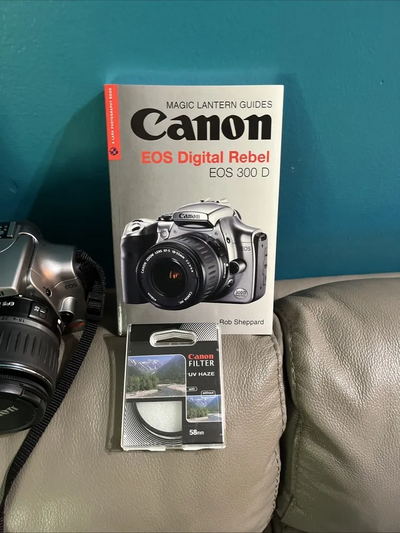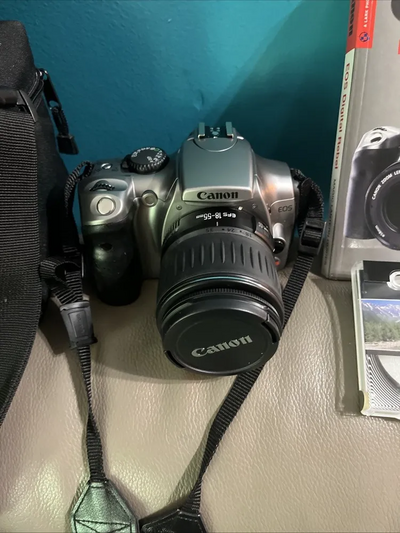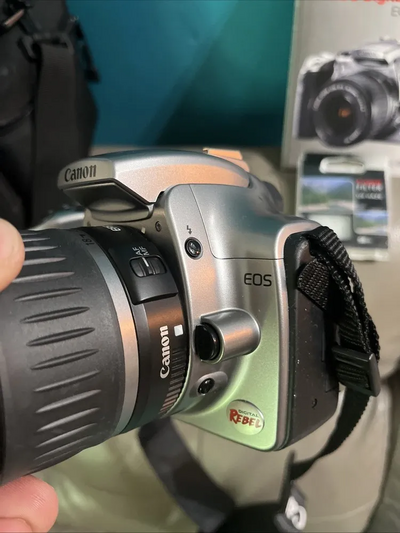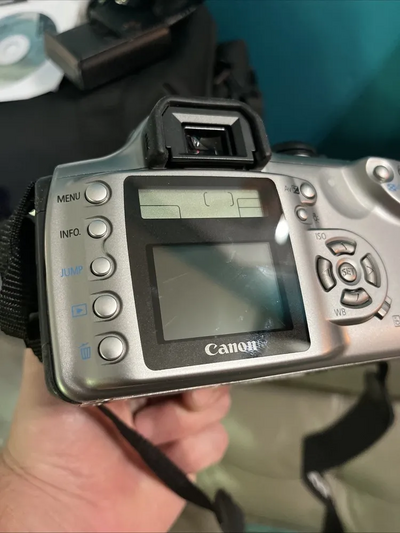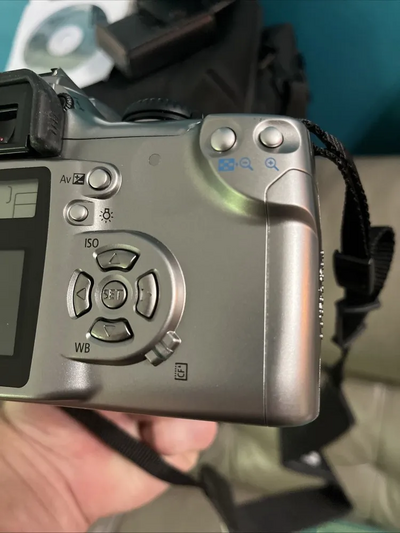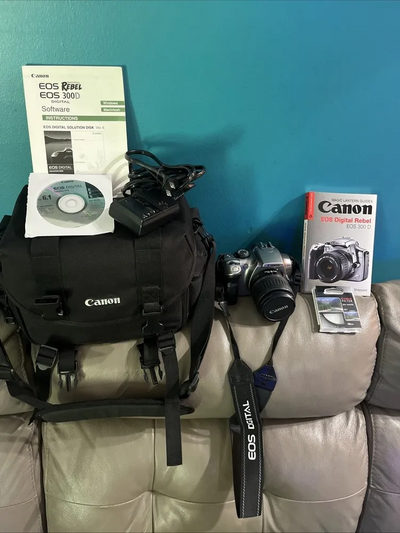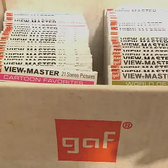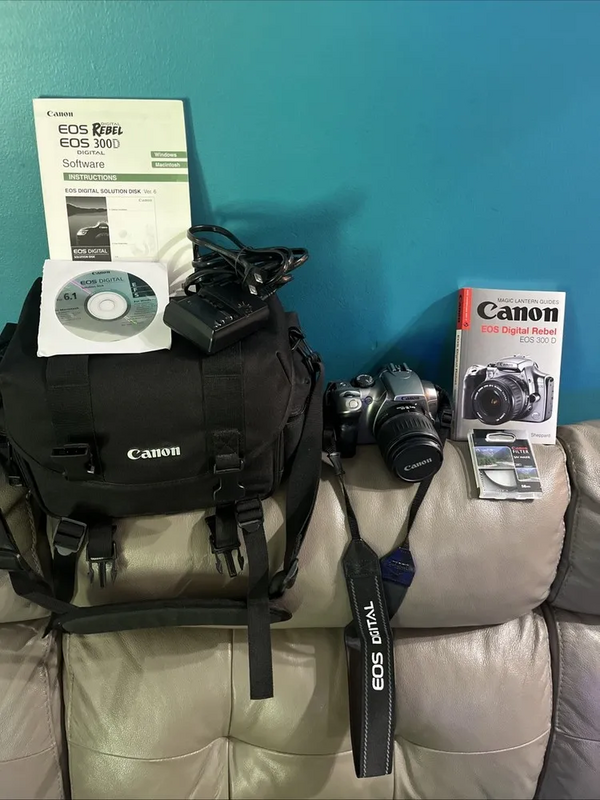
Canon Eos 300d
| Brand | Canon 2003 |
| Model | 1570509919 |
| Released Year | 2003 |
| Type | Digital Cameras |
| Series | Eos digital rebel |
| Optical Zoom | --- |
| Status | Discontinued |
Quick view
Overview
The Canon EOS 300D, also known as the EOS Digital Rebel in North America, was launched in 2003 as one of the pioneering affordable digital SLR cameras targeted at enthusiast photographers. It features a 6.3 megapixel APS-C size CMOS sensor, producing high-quality images with remarkable detail for its time. The camera utilizes Canon's EF lens mount system, providing compatibility with a vast range of lenses. Its DIGIC image processor manages image quality and color rendering efficiently. The body design is compact and ergonomically optimized for comfortable handheld use. Additionally, the EOS 300D supports RAW image capture and has a 2.5-inch LCD for image review and menu navigation.
Specifications
| Maximum Aperture | f3.5 |
| Digital Zoom | -- |
| MPN | 1570509919 |
| Battery Type | Lithium-Ion |
| Colour | Silver |
| Series | Canon EOS Digital Rebel |
| Type | Digital SLR |
| Maximum Resolution | 6.3 MP |
| Model | Canon EOS 300D |
| Connectivity | USB |
| Optical Zoom | --- |
| Features | Auto Power Save, Built-in Flash, CMOS Sensor, Date/Time Stamp, Interchangeable Lenses, Tripod Thread, Viewfinder, Charger Included |
| Country/Region of Manufacture | Japan |
| Item Weight | 560GR |
| Release Year | 2003 |
| Sensor Type | APS-C CMOS |
| Effective Megapixels | 6.3 MP |
| Image Processor | DIGIC |
| Lens Mount | Canon EF |
| ISO Range | 100-1600 |
| Autofocus Points | 3 |
| Shutter Speed Range | 30 sec to 1/4000 sec |
| Continuous Shooting Speed | 2.5 fps |
| Viewfinder | Optical pentamirror |
| LCD Screen Size | 2.5 inches |
| LCD Resolution | 110,000 pixels |
| Storage Media | CompactFlash Type I/II |
| Image Formats | JPEG, RAW (CRW) |
| Weight | Approx. 620 g (body only) |
| Battery | BP-511/511A Lithium-ion battery |
| Dimensions | 131 x 97 x 70 mm |
| White Balance | Auto, Presets, Custom |
| Metering Modes | Evaluative, Partial, Spot, Center-weighted |
Images
Key Advantages
The EOS 300D's key advantage was its affordability, making DSLR photography accessible to a wider audience. Its APS-C sensor size allowed for excellent image quality compared to compact digital cameras of the era. Interchangeable lens support using Canon's EF mount offered great versatility in shooting styles. The camera's relatively lightweight and small body made it portable and user-friendly. Fast autofocus performance and accurate metering systems improved shooting reliability. Furthermore, capturing images in RAW format provided photographers with greater post-processing flexibility.
Limitations
Despite its strengths, the EOS 300D had some limitations by modern standards. The 6.3 megapixel resolution is low compared to current digital camera standards. It had a relatively slow continuous shooting speed of around 2.5 frames per second. The autofocus system had fewer focus points and was less advanced, limiting accuracy in some situations. The lack of live view and video recording reduced its versatility. Its startup and shot-to-shot times were slower than later models. Lastly, the LCD screen resolution was modest, affecting image review clarity.
FAQ
What is the sensor size of the Canon EOS 300D?
The EOS 300D features an APS-C sized CMOS sensor measuring approximately 22.7 x 15.1 mm.
Does the Canon EOS 300D support RAW image format?
Yes, the EOS 300D can capture images in RAW format, allowing for greater post-processing flexibility.
What kind of lenses are compatible with the EOS 300D?
It uses Canon EF lens mount, compatible with a wide range of Canon EF lenses.
Is the Canon EOS 300D capable of recording video?
No, the EOS 300D does not support video recording.
What is the maximum resolution of images taken by the EOS 300D?
The maximum image resolution is 3040 x 2016 pixels, corresponding to 6.3 megapixels.
Does the EOS 300D have built-in image stabilization?
No, the EOS 300D does not include in-body image stabilization; stabilization depends on lens features.
What type of memory card does the EOS 300D use?
The camera uses CompactFlash (CF) Type I or Type II cards for image storage.
Disclaimer
The content on is provided for general informational purposes only. We do not guarantee the accuracy, completeness, or reliability of any information, specifications, or visuals presented on the site.
is not responsible for any content, images, or data uploaded or shared by users. Users are solely responsible for the content they submit.
We may include links to third-party websites for convenience. We do not endorse or take responsibility for the content or policies of any external sites.
Use of the site is at your own risk. Always verify critical information independently before making decisions based on content from this website.

